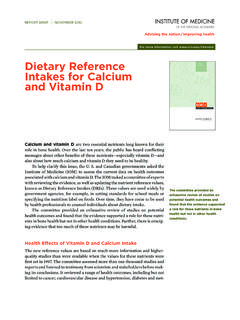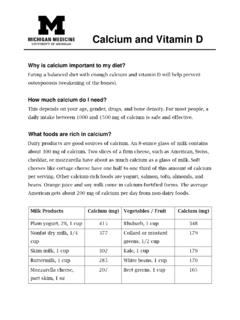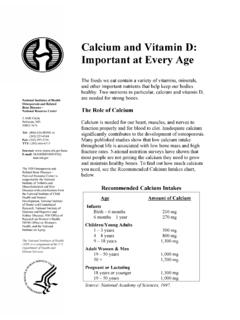Transcription of Vit D, Calcium and adolescents - UOA
1 vitamin D, Calcium , and Dairy Intakes and Stress Fractures Among Female adolescents Kendrin R. Sonneville, ScD, RD; Catherine M. Gordon, MD, MSc; Mininder S. Kocher, MD, MPH; Laura M. Pierce, BA; Arun Ramappa, MD; Alison E. Field, ScD [+-] Author Affiliations Author Affiliations: Division of adolescent /Young Adult Medicine, Department of Medicine (Drs Sonneville, Gordon, and Field and Ms Pierce) and Departments of Endocrinology (Dr Gordon) and Orthopedic Surgery (Dr Kocher), Children's Hospital Boston, and Channing Laboratory, Department of Medicine, Brigham and Women's Hospital (Dr Field), Harvard Medical School, and Department of Epidemiology, Harvard School of Public Health (Dr Field), Harvard University, and Division of Sports Medicine, Department of Orthopedic Surgery, Beth Israel Deaconess Medical Center (Dr Ramappa), Boston, Massachusetts. Arch Pediatr Adolesc Med. 2012;166(7):595-600.
2 Published online ABSTRACT ABSTRACT | METHODS | RESULTS | COMMENT | ARTICLE INFORMATION | REFERENCES Objective To identify whether Calcium , vitamin D, and/or dairy intakes are prospectively associated with stress fracture risk among female adolescents . Design Prospective cohort study. Setting adolescent girls living throughout the United States. Participants A total of 6712 girls aged 9 to 15 years at baseline in the Growing Up Today Study, an ongoing prospective cohort study. Main Exposures Dairy, Calcium , and vitamin D intakes assessed by food frequency questionnaire every 12 to 24 months between 1996 and 2001. Main Outcome Measure Incident stress fracture that occurred between 1997 and 2004 as reported by mothers of the participants in 2004. Cox proportional hazards models were used to examine associations. Results During 7 years of follow-up, of the girls developed a stress fracture.
3 Dairy and Calcium intakes were unrelated to risk of developing a stress fracture. However, vitamin D intake was inversely related to stress fracture risk. The multivariable-adjusted hazard ratio of stress fracture for the highest vs the lowest quintile of vitamin D intake was (95% CI, ; Ptrend = .07). We conducted a stratified analysis to estimate the association between vitamin D intake and stress fracture risk among girls participating in at least 1 h/d of high-impact activity, among whom of the stress fractures occurred, and found that higher vitamin D intake predicted significantly lower risk of stress fracture (Ptrend = .04). Conclusions vitamin D intake is associated with lower stress fracture risk among adolescent girls who engage in high levels of high-impact activity. Neither Calcium intake nor dairy intake was prospectively associated with stress fracture risk. As participation in organized sports and athletic specialization among children and adolescents have increased, so too has the recognition of overuse ,2 Stress fractures, which occur when stresses on bone exceed the bone's capacity to withstand and heal from those forces, are a particularly common type of injury seen in both competitive and recreational We previously reported that nearly 4% of the adolescent and young adult girls in our cohort developed a stress fracture during 7 years of The risk of stress fracture is influenced by extrinsic (training regimen, type of sport), intrinsic (sex, race/ethnicity)
4 , biomechanical, anatomical, and hormonal Nutritional intakes, particularly Calcium , which is needed for bone mineralization, and vitamin D, which is needed for maintaining Calcium homeostasis and bone remodeling, have been suggested as protective against stress Although consuming Calcium and Calcium -rich dairy products is routinely encouraged for optimal bone health, the evidence for this recommendation has been ,6 Further, while vitamin D deficiency is relatively common among adolescents ,7,8 data are lacking on the role of vitamin D intake, whether sufficient or in excess of recommended intake,9 on bone ,11 Adolescence is the most critical period for bone mineral accrual12- 16 and therefore is considered an important window for the prevention of long-term consequences of low bone mineral content such as postmenopausal osteoporosis. The relationship between dietary intake during adolescence and short-term consequences of low bone mineral content, however, is understudied.
5 In a cross-sectional analysis of adolescent girls, intakes of dairy, Calcium , and vitamin D were all unrelated to stress fractures after controlling for Because bone mineral is accrued over time, however, the contribution of long-term dietary exposure on stress fracture risk cannot be examined in cross-sectional studies or studies of short duration. Physical activity is the primary modifiable stimulus for increased bone growth and development in adolescents ,5 and weight-bearing activity during childhood and adolescence seems to be a more important factor for peak bone mass than dietary Despite known benefits of physical activity on bone mineral content,19 there is a threshold over which the risk of stress fracture increases significantly among adolescent The combined effects of diet and exercise on bone health are still unknown. More research is needed to explore whether protective dietary factors could mitigate the risk of stress fracture among adolescents who regularly engage in high-impact activities.
6 Stress fracture is a source of significant morbidity among female athletes during However, few studies have identified modifiable risk factors for stress fracture among female adolescents , other than participation in high-impact ,17 As such, prospective studies are needed to identify other modifiable risk factors for stress fracture among this population. The aim of this study was to identify dietary factors that are prospectively associated with risk of stress fracture among female adolescents and, in particular, those who are at highest risk for stress fracture. METHODS ABSTRACT | METHODS | RESULTS | COMMENT | ARTICLE INFORMATION | REFERENCES Participants were members of the Growing Up Today Study (GUTS), an ongoing cohort study of adolescents throughout the United States that was established in 1996. Participants in GUTS are the offspring of women in the Nurses' Health Mothers of children aged between 9 and 14 years in 1996 were sent a detailed letter that outlined the purposes of GUTS and were asked to provide parental consent for their children to enroll.
7 Of those invited, of their daughters (n = 9039) returned completed questionnaires, thereby assenting to participate in the cohort. Additional details of enrollment are reported The Human Subjects Committee at Brigham and Women's Hospital approved GUTS. This analysis was approved by that committee and by the Committee on Clinical Investigation at Children's Hospital Boston. EXPOSURES Dietary intake, including intake of dairy foods and soda, was assessed annually from 1996 through 1999 and again in 2001 using the previously validated Youth/ adolescent ,23 The Youth/ adolescent Questionnaire is a self-administered, semiquantitative food frequency questionnaire that assesses intake during the past year using portion sizes for foods that are appropriate for each age as determined from analyses of national nutrition ,23 The development, reproducibility, and validation of the Youth/ adolescent Questionnaire have been previously ,23 Briefly, participants were asked how frequently they used a typical portion size of specified foods on average during the past year.
8 Nutrient intakes were computed by multiplying the frequency of consumption of each unit of food by the nutrient content of the specified portions based on the nutrient values in foods obtained from US Department of Agriculture sources and food manufacturers; intakes include Calcium or vitamin D in foods routinely fortified with these Participants also reported Calcium supplement and multivitamin use, physical activity, menstrual status, weight, and height annually from 1996 through 2001. We calculated body mass index (BMI; calculated as weight in kilograms divided by height in meters squared) from self-reported weight and height information. Despite concern that self-reported weight and thus BMI are biased, a strong correlation between BMI calculated from self-reported vs measured height and weight has been observed in adolescent ,26 The total number of hours of physical activity per week was assessed by asking participants to report the number of hours they spent doing 18 different types of physical activity in each of the 4 seasons.
9 Reported physical activity that exceeded 40 h/wk was considered implausible and was not used in the analysis. High-impact activity was computed as the sum of the average hours per week a participant reported engaging in basketball, running, soccer, tennis, cheerleading, or Girls who reported participating in an average of at least 1 h/d of high-impact activity were defined as having high levels of high-impact activity. On each questionnaire, girls were asked whether their menstrual periods had started and, if yes, how old they were when their periods began. Girls were classified as having a family history of low bone density or osteoporosis if their mothers indicated having a history of low bone density or osteoporosis on the 2005 Nurses' Health Study questionnaire. OUTCOME Incident stress fracture was the primary outcome. Stress fractures were reported in 2004 by the participants' mothers, who were registered female nurses participating in the Nurses' Health Study II.
10 Mothers were asked whether a doctor had ever said that their child had a stress fracture and were asked to report the age at which the stress fracture developed and the site (foot, arm, leg, wrist, or other) of the stress fracture. SAMPLE FOR ANALYSIS Cases that occurred prior to enrollment in GUTS in fall 1996 and reports of a stress fracture without an age at diagnosis were excluded. A total of 6712 girls whose mothers responded to the question about stress fractures were included in the analysis. STATISTICAL ANALYSIS Cox proportional hazards models were used for all multivariable analyses. We modeled Calcium and vitamin D intakes in 2 ways: (1) Calcium and vitamin D from dietary intake only, and (2) Calcium and vitamin D from both dietary and supplement intakes. Calcium and vitamin D intakes were modeled as quintiles, with the lowest quintile serving as the reference. Dairy intake was modeled as servings per day (0, 1, 2, and 3 servings/d), with 0 servings as the reference.









